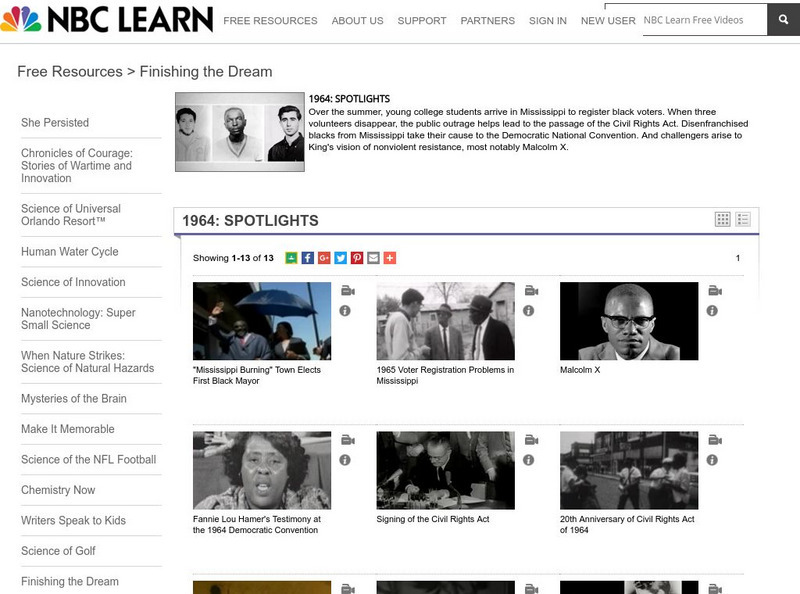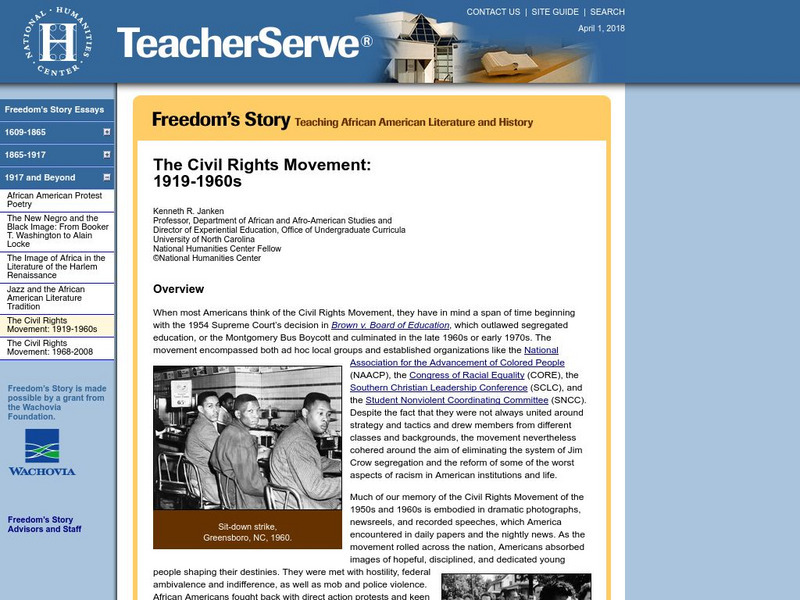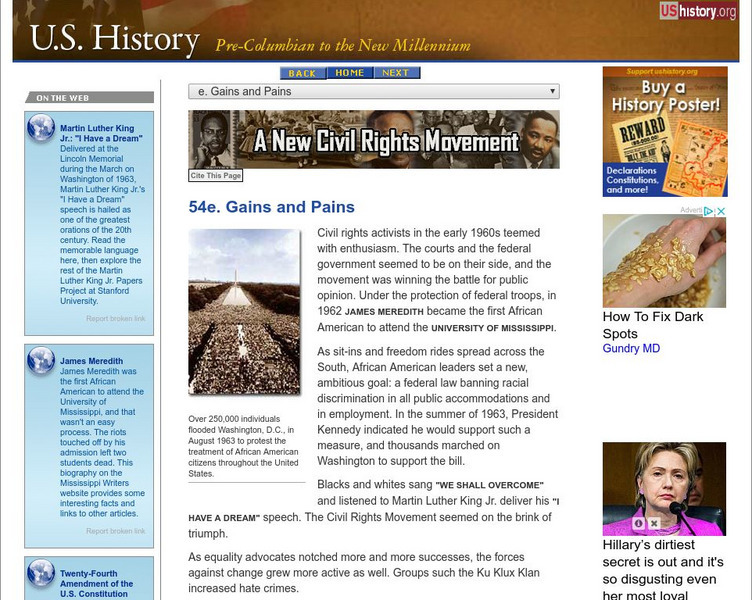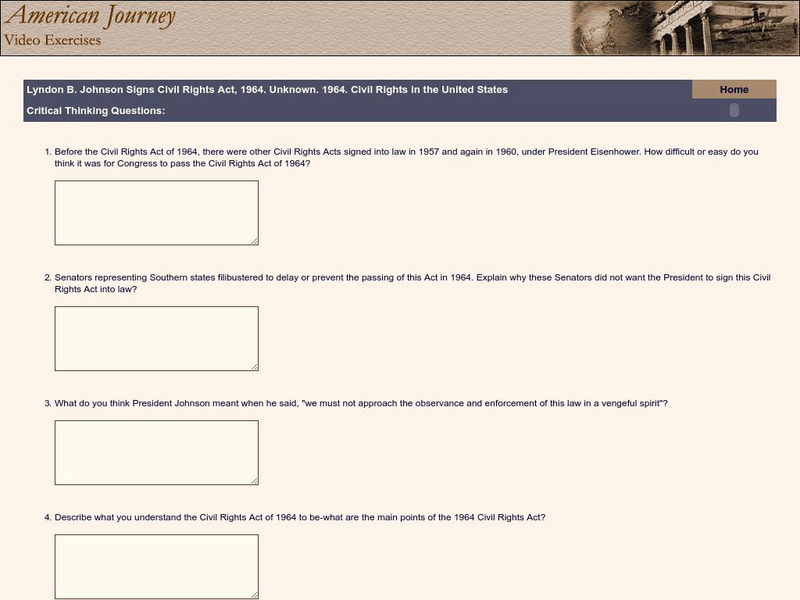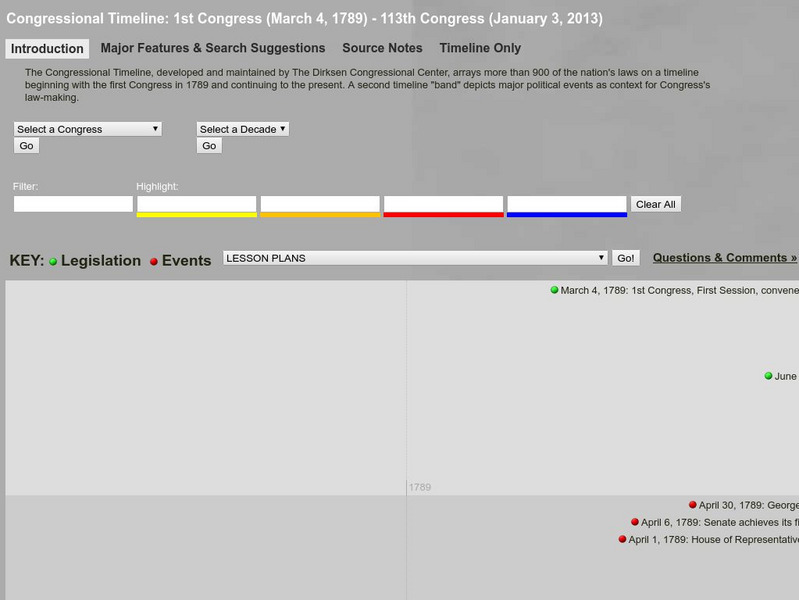Hi, what do you want to do?
Library of Congress
Loc: congress.gov: Lilly Ledbetter Fair Pay Act of 2009
The Lilly Ledbetter Fair Pay Act, 2009 amends the Civil Rights Act of 1964. It redefines the circumstances under which unlawful employment practice occurs. A summary of the Bill and its status is included.
University of Virginia
Virginia Center for Digital History: Television News of the Civil Rights Era
A rich collection of streaming video samples of television news footage from 1950 to 1970, along with an assortment of primary source documents, first-person accounts, a glossary of terms, and essays and analysis for learning about the...
University of Groningen
American History: Documents: George C. Wallace Speech: The Civil Rights Movement
View the complete speech by Alabama governor George Wallace condemning the Civil Rights Act.
Digital History
Digital History: Affirmative Action and the Case of Allan Bakke [Pdf]
The history of affirmative action was interwoven with the Civil Rights Act of 1964 and the Voting Rights Act of 1965. Read about how the federal government under both President Kennedy and President Nixon attempted to open up jobs to...
Curated OER
National Park Service: International Civil Rights Walk of Fame: Lyndon Johnson
Read about President Lyndon Johnson's on how to end poverty in the United States as well as how to protect civil rights.
NBC
Nbc Learn: Finishing the Dream: 1964: Spotlights
A collection of archival video clips highlighting the African American struggle for equal voting rights in 1964. Looks at the Mississippi Freedom Summer where college students helped to register black voters, the murder of three of those...
Free Management Library
Employee Law: Civil Rights Act of 1964
This site contains the original text of the legislation, with related links.
Khan Academy
Khan Academy: Us History: 1945 1980:civil Rights Act 1964/voting Rights Act 1965
Learn about the civil rights legislation that outlawed discrimination in jobs, education, housing, public accommodations, and voting.
Other
National Council for the Social Studies: Cloture Motion to Cease Debate
Using the Civil Rights Bill of 1964 as an example, students will understand the congressional procedures of cloture and filibuster. An in-depth article on how a filibuster was used during debate on this bill, the actual signed cloture...
National Humanities Center
National Humanities Center: Teacher Serve: The Civil Rights Movement: 1919 1960s
Article provides an overview of the Civil Rights Movement in America between 1919 and the 1960s with detailed discussion on racial equality, nonviolence and passive resistance, and segregation.
PBS
Pbs Learning Media: Martin Luther King Jr.: Civil Rights Leader
Students will explore how King's deep-seated commitment to nonviolence contributed to the expansion of social justice in the United States, particularly for African Americans.
Cornell University
Cornell University: Law School: Civil Rights and Discrimination
This site from the Cornell University School of Law provides an overview of civil rights legislation, including an explanation of the Civil Rights Act of 1964. There are links to other sites on the subject of civil rights in general.
Other
Afl Cio: Time for Working Women to Earn Equal Pay
This article discusses the impact of the Equal Pay Act of 1963 and the Civil Rights Act of 1964 in achieving equal pay for women. Links to related articles.
Independence Hall Association
U.s. History: Gains and Pains
Read about the legal gains made by the civil rights movement, including the Civil Rights Act of 1964, juxtaposed against the real-life actions meant to deny African Americans their right to racial equality not just legally, but...
Digital History
Digital History: Discrimination in Public Accommodations [Pdf]
Segregation and Jim Crow laws codified a color line in the United States. African-Americans began pushing back against segregation in the 1950s and 1960s. Read about the non-violent actions taken and how these actions resulted in the...
Employment Spot
Employment Spot: Minority Resources
Title VII of the Civil Rights Act of 1964 protects individuals against employment discrimination on the basis of race, color, national origin, sex, or religion. Before starting the search, you should know your rights in the workforce.
iCivics
I Civics: Plessy v. Ferguson (1896)
This mini-instructional activity covers the basics of the Supreme Court's decision that it was constitutional to keep black and white people segregated as long as the accommodations for each race were "equal." Students learn about the...
iCivics
I Civics: Eeoc v. Abercrombie & Fitch (2015)
This mini-instructional activity explores the Supreme Court's decision regarding a company's discrimination against a Muslim woman during the hiring process. Students learn how Title VII of the Civil Rights Act of 1964 prohibits...
iCivics
I Civics: Lau v. Nichols (1974)
This mini-lesson covers the basics of the Supreme Court's decision that required public schools to provide language supports to English and multilingual learners. Students learn how Lau's arguments relate to the landmark case, Brown v....
Raleigh Charter High School
Mrs. Newmark's Page: Civil Rights
This interactive activity focuses on the Civil Rights Movement.
Cengage Learning
Video Exercises: Lyndon Johnson Signs Civil Rights Act
Here are five "Critical thinking questions," to accompany a viewing of an "American Journey Online," video on the signing of the Civil Rights act of 1964. Though intended for students who have watched a specific video, the questions...
Other
Dirksen Congressional Center: Congressional Timeline
The title does not give this site its just due. This is an amazing site that provides information on every Congress beginning with the 73rd (1933-35). The timeline features "partisan composition, the presidential administration, a list...
US National Archives
Nara: Martha Griffiths and the Equal Rights Amendment
A good look at the way the Equal Rights Amendment moved through Congress. Find images of the discharge petition and joint resolution
Black Past
Black Past: Wilkins, Roy
This encyclopedia entry recounts briefly the life of Roy Wilkins, a very influential civil rights leader.








![Digital History: Affirmative Action and the Case of Allan Bakke [Pdf] Website Digital History: Affirmative Action and the Case of Allan Bakke [Pdf] Website](https://static.lp.lexp.cloud/images/attachment_defaults/resource/large/FPO-knovation.png)

